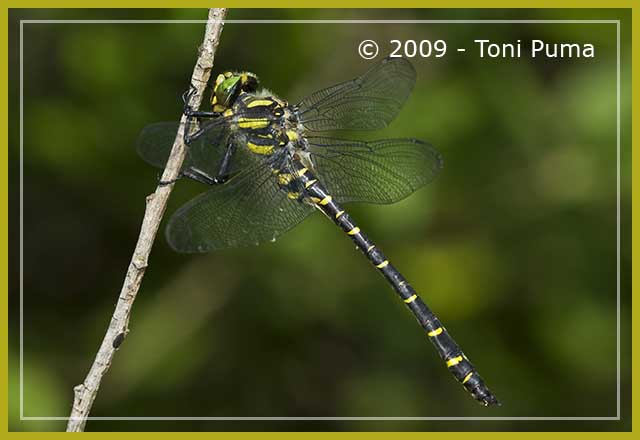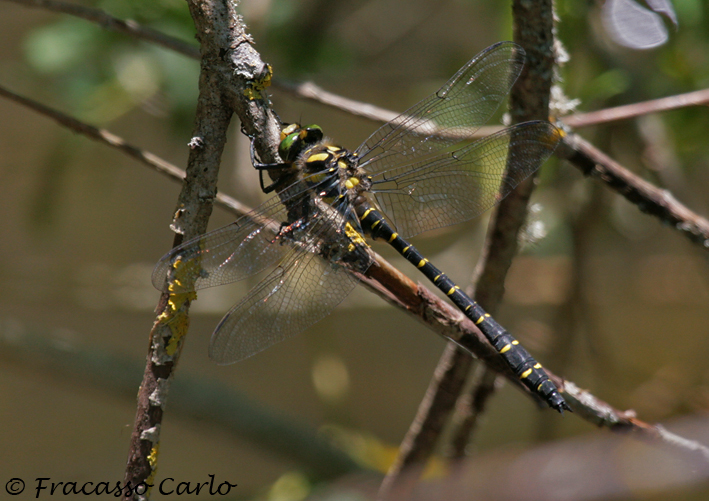Italienische Quelljungfer
© Clemens M. Brandstetter
 (from Boudot & al. 2009:153): Cordulegaster trinacriae replaces C. b. boltonii in the southern half of Italy and in Siciliy. Its precise northern limit remains unclear. Some populations were recently found during 2008 to be flourishing, particulary in nature reserves, but some old localities are now destroyed by urbanisation, water pollution and desiccation of streams.
(from Boudot & al. 2009:153): Cordulegaster trinacriae replaces C. b. boltonii in the southern half of Italy and in Siciliy. Its precise northern limit remains unclear. Some populations were recently found during 2008 to be flourishing, particulary in nature reserves, but some old localities are now destroyed by urbanisation, water pollution and desiccation of streams.
 Società italiana per lo studio e la conservazione delle libellule.
Società italiana per lo studio e la conservazione delle libellule.
Die Italienische Quelljungfer, Cordulegaster trinacriae Waterston 1976, ersetzt in Süditalien und Sizilien die Zweigestreifte Quelljungfer. Ihre Verbreitungsgrenze im Norden ist unklar und ist von der vorgenannten Art kaum zu unterscheiden.
Froufe & al. (2014) präsentieren eine Studie über genetische Untersuchungen an der Gattung Cordulegaster. Die bisher traditionell unterschiedenen Artengruppen haben sich auch genetisch bestätigt: "Although Odonata are a key component of many freshwater ecosystems, their taxonomy and evolutionary history is still far from being well resolved. In the present study, we report the first molecular phylogeny for the Western Palaearctic Cordulegaster genus (Odonata: Anisoptera: Cordulegastridae). We sequenced fragments of both mitochondrial and nuclear genes [cytochrome c oxidase I (COI) and Internal Transcribed Spacer-1 (ITS-1)] from eight species and 13 subspecies, from western, southern and central Europe, Turkey, and Morocco. Our data support the existence of two major groups corresponding to the traditional boltonii– and bidentata-groups. Both groups are monophyletic based on COI sequences and the distinctiveness of Cordulegaster princeps, Cordulegaster trinacriae, Cordulegaster picta and Cordulegaster heros relative to Cordulegaster boltonii, and Cordulegaster helladica and Cordulegaster insignis relative to Cordulegaster bidentata, is confirmed. All species are also monophyletic for ITS-1, with the exception of Cordulegaster helladica buchholzi, which shares the haplotype with C. insignis. Although moderate levels of genetic diversity were found within C. boltonii, there was no clear separation among the four subspecies, with the exception of the populations of Cordulegaster boltonii algirica from North Africa. Similarly, no genetic differentiation was found between the two subspecies of C. bidentata, Cordulegaster bidentata bidentata and Cordulegaster bidenta sicilica.."

Italienische Quelljungfer am Fluss Tellesimo, Prov. Ragusa, Sizilien – Foto: Toni Puma.

Männchen der Italienischen Quelljungfer, Molise, Italien – Foto: Carlo Fracasso.
Literatur:
Boudot J.-P., V. J. Kalkman, M. Amorín, T. Bogdanović, A. Rivera,G. Degabriele, J.L. Dommanget, S. Ferreira, B. Garrigós, M. Jović, M. Kotarac, W. Lopau, M. Marinov, N. Mihoković, E. Riservato, B. Samraoui & W. Schneider 2009: Atlas of the Odonata of the Mediterranean and North Africa. – Libellula Supplement 9:1-256.
Froufe E., Ferreira S., Boudot J.-P., Alves P.C. & D. J. Harris 2014: Molecular phylogeny of the Western Palaearctic Cordulegaster taxa (Odonata: Anisoptera: Cordulegastridae). – Biolog. Journ. Linn. Soc. 111: 49,57.
Waterston A. R. 1976: On the genus Cordulegaster Leach, 1815 (Odonata) with special reference to the Sicilian species. – Trans. R. Soc. Edinb. 69 (19): 457-466, f 1-24.
